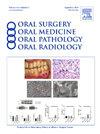Atypical vascular neoplasm with TFE3 immunohistochemical expression, suggestive of epithelioid hemangioendothelioma
IF 1.9
3区 医学
Q2 DENTISTRY, ORAL SURGERY & MEDICINE
Oral Surgery Oral Medicine Oral Pathology Oral Radiology
Pub Date : 2025-07-21
DOI:10.1016/j.oooo.2025.04.008
引用次数: 0
Abstract
Epithelioid hemangioendothelioma (EHE) is a rare tumor of the head and neck region which was first described by Weiss and Enziger in 1982. It was considered an intermediate malignant potential tumor but currently, the WHO classifies it as a malignant neoplasm. The common molecular driver of the neoplasm is a gene fusion of WWTR1::CAMTA1. However, a much less common subset of cases display YAP1::TFE3 gene fusion. Clinically, the lesion presents as a slow-growing mass with a tendency for regional lymph node metastasis. Histopathology for EHE can share features with other vascular lesions both benign and malignant lesions ranging from epithelioid hemangioma to epithelioid angiosarcoma. Immunohistochemical markers are not always helpful when determining vascular lesions from each other. Vascular lesions stain positive with CD31, and ERG which is helpful in distinguishing this tumor from other epithelioid morphology neoplasms. This case presents a 42-year-old male with a 4-month history of right buccal mucosa swelling. The lesion was thought to be excised at original biopsy but in approximately 2 weeks recurred with rapid growth. The biopsy showed a vascular lesion with an epithelioid morphology, cellular pleomorphism, increased mitoses, endothelial hyperplasia, and an infiltrate of eosinophils. A confounding morphology with a concerning rapid growth rate. IHC testing was positive for CD31, ERG, and TFE3 suggesting an epithelioid hemangioendothelioma but molecular tests are still pending as of the writing of this abstract.
非典型血管肿瘤伴TFE3免疫组化表达,提示上皮样血管内皮瘤
上皮样血管内皮瘤(EHE)是一种罕见的头颈部肿瘤,于1982年由Weiss和Enziger首次报道。它被认为是一种中度恶性潜在肿瘤,但目前世界卫生组织将其归类为恶性肿瘤。常见的肿瘤分子驱动因子是WWTR1::CAMTA1的基因融合。然而,很少有病例显示YAP1::TFE3基因融合。临床表现为生长缓慢的肿块,有局部淋巴结转移的倾向。从上皮样血管瘤到上皮样血管肉瘤,EHE的组织病理学与其他良性和恶性血管病变具有共同的特征。免疫组织化学标记在确定血管病变时并不总是有用的。血管病变CD31和ERG染色呈阳性,这有助于将该肿瘤与其他上皮样形态肿瘤区分开来。本病例为42岁男性,右颊黏膜肿胀4个月。病变在最初的活检中被认为是切除的,但在大约2周后复发并快速生长。活检显示血管病变呈上皮样形态,细胞多形性,有丝分裂增加,内皮细胞增生,嗜酸性粒细胞浸润。生长速度快的令人困惑的形态。免疫组化检测CD31、ERG和TFE3呈阳性,提示为上皮样血管内皮瘤,但在撰写本文时,分子检测仍未完成。
本文章由计算机程序翻译,如有差异,请以英文原文为准。
求助全文
约1分钟内获得全文
求助全文
来源期刊

Oral Surgery Oral Medicine Oral Pathology Oral Radiology
DENTISTRY, ORAL SURGERY & MEDICINE-
CiteScore
3.80
自引率
6.90%
发文量
1217
审稿时长
2-4 weeks
期刊介绍:
Oral Surgery, Oral Medicine, Oral Pathology and Oral Radiology is required reading for anyone in the fields of oral surgery, oral medicine, oral pathology, oral radiology or advanced general practice dentistry. It is the only major dental journal that provides a practical and complete overview of the medical and surgical techniques of dental practice in four areas. Topics covered include such current issues as dental implants, treatment of HIV-infected patients, and evaluation and treatment of TMJ disorders. The official publication for nine societies, the Journal is recommended for initial purchase in the Brandon Hill study, Selected List of Books and Journals for the Small Medical Library.
 求助内容:
求助内容: 应助结果提醒方式:
应助结果提醒方式:


